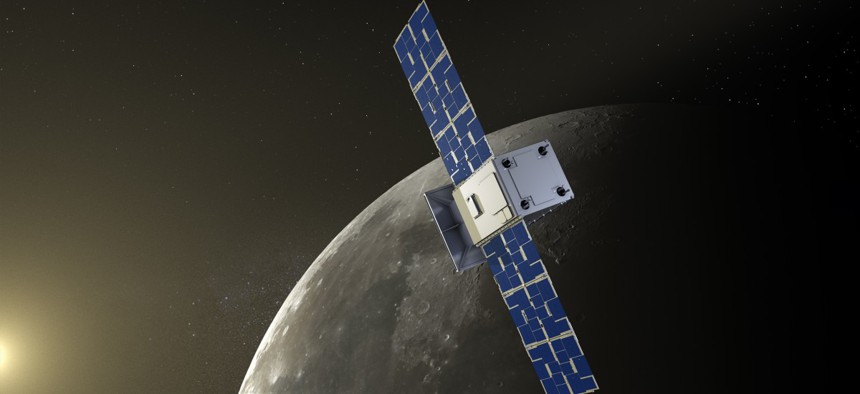NASA CAPSTONE Spacecraft Paves Way for Future Artemis Missions

CAPSTONE, a microwave oven-sized CubeSat, will fly in cislunar space – the orbital space near and around the Moon. Daniel J. Rutter/NASA
The spacecraft is testing an orbit that will be important for future Artemis missions, while demonstrating new tech capabilities.
NASA’s Cislunar Autonomous Positioning System Technology Operations and Navigation Experiment—or CAPSTONE—spacecraft finished the final maneuvers to place the spacecraft in its desired orbit around the moon, which will help future Artemis missions that seek to bring astronauts back to the moon and put the first on Mars.
CAPSTONE is a technology demonstration to show the reliability of new capabilities that can be used in future missions. On Monday, CAPSTONE fine-tuned its path in the orbit it arrived at last week. The spacecraft is now in the operational phase of its mission, where it will test an orbit critical to future Artemis missions and showcase the new technologies for spacecraft to operate near the moon.
Specifically, CAPSTONE is testing the same orbit that is planned for Gateway—an upcoming moon-orbiting space station to support the Artemis missions. CAPSTONE is the first spacecraft to “fly in a near-rectilinear halo orbit (NRHO) and the first CubeSat to operate at the moon.” CubeSats are small, cube-shaped satellites that can be added as auxiliary payloads to already-planned NASA missions.
CAPSTONE will collect data on the orbit for at least six months to support operational planning for Gateway, which is set to fully launch in 2024.
“Missions like CAPSTONE allow us to reduce risk for future spacecraft, giving us a chance to test our understanding and demonstrate technologies we intend to use in the future,” Jim Reuter, associate administrator for NASA’s Space Technology Mission Directorate, said. “Partnering with innovative U.S. companies, including several small businesses, on CAPSTONE has given us the chance to forge new ground, merging commercial interests with NASA’s goals.”
After launching on June 28, 2022, CAPSTONE took four months to reach its target orbit, during which it overcame communication and propulsion challenges. The spacecraft performed an initial orbit insertion maneuver on Nov. 13. Afterwards, the CAPSTONE mission operations team—led by mission-support company Advanced Space—analyzed the spacecraft’s data to verify that it was in the target orbit and performed two clean-up maneuvers to adjust its track.
“NASA’s partnership with Advanced Space on CAPSTONE is enabling NASA to gain critical, additional capabilities at a lower cost,” NASA Administrator Bill Nelson said. “CAPSTONE is part of our new era of human exploration at the moon, testing the unique orbit planned for the Gateway lunar space station.”
CAPSTONE’s mission also includes two tech demonstrations, which could be used for future spacecrafts. The first is the Cislunar Autonomous Positioning System—or CAPS—a navigational software allowing the spacecraft to operate near the moon to determine its position in space without only relying on tracking from Earth. This technology—developed by Advanced Space—will be demonstrated by directly communicating with NASA’s Lunar Orbiter, which has been orbiting the moon since 2009. The second demonstration is a one-way range using a chip-scale atomic clock to allow the spacecraft to determine its position in space without needing a dedicated downlink to ground stations.
“We have been working to this point since we started the company over 11 years ago. Getting into this orbit at the Moon validates so much hard work and grit by the combined CAPSTONE mission operations team,” Bradley Cheetham, principal investigator for CAPSTONE and chief executive officer of Advanced Space, said. “The capabilities we have demonstrated and the technologies still to be matured will support future missions for decades to come.”
According to NASA, this endeavor is a way for NASA and industry to collaborate “to provide rapid results and feedback to inform future exploration and science missions.”
CAPSTONE is commercially owned and operated by Advanced Space and was designed and built by Terran Orbital. The operations are performed by both Advanced Space and Terran Orbital. Additionally, Stellar Exploration, Space Dynamics Laboratory, Orion Space Solutions, Tethers Unlimited, Inc. and Morehead State University supported the mission.
Meanwhile, the demonstrations are funded by NASA’s Small Spacecraft Technology program within its Space Technology Mission Directorate. CAPSTONE’s navigation technology is supported by the agency’s Small Business Innovation Research and Small Business Technology Transfer program. Additionally, the launch and support mission operations were funded by the Artemis Campaign Development Division within the agency’s Exploration Systems Development Mission Directorate.
NEXT STORY: NARA’s Chief Innovator Won Big Last Week






